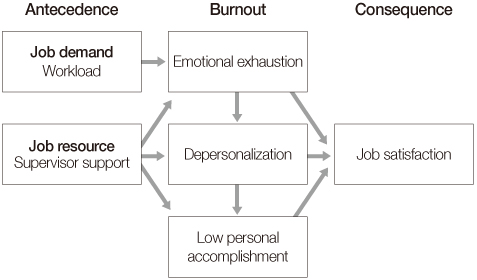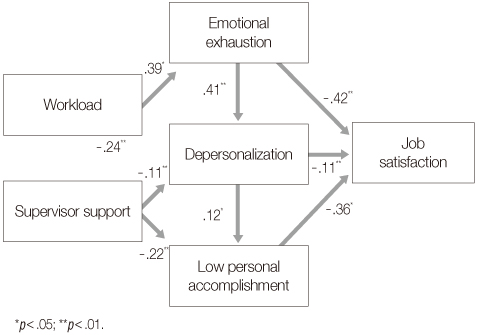J Korean Acad Nurs.
2013 Feb;43(1):114-122. 10.4040/jkan.2013.43.1.114.
Analysis of Burnout and Job Satisfaction among Nurses Based on the Job Demand-Resource Model
- Affiliations
-
- 1Red Cross College of Nursing, Chung-Ang University, Seoul, Korea. yhyom@cau.ac.kr
- KMID: 1732671
- DOI: http://doi.org/10.4040/jkan.2013.43.1.114
Abstract
- PURPOSE
The purpose of this study was to examine burnout and job satisfaction among nurses based on Job Demand-Resource Model.
METHODS
A survey using a structured questionnaire was conducted with 464 hospital nurses. Analysis of data was done with both SPSS Win 17.0 for descriptive statistics and AMOS 18.0 for the structural equation model.
RESULTS
The hypothetical model yielded the following Chi-square=34.13 (p = <.001), df=6, GFI=.98, AGFI=.92, CFI=.94, RMSR=.02, NFI=.93, IFI=.94 and showed good fit indices. Workload had a direct effect on emotional exhaustion (beta = 0.39), whereas supervisor support had direct effects on emotional exhaustion (beta = -0.24), depersonalization (beta = -0.11), and low personal accomplishment (beta = -0.22). Emotional exhaustion (beta = -0.42), depersonalization (beta = -0.11) and low personal accomplishment (beta = -0.36) had significant direct effects on job satisfaction.
CONCLUSION
The results suggest that nurses' workload should be decreased and supervisor's support should be increased in order to retain nurses. Further study with a longitudinal design is necessary.
Keyword
MeSH Terms
Figure
Cited by 1 articles
-
Psychosocial Well-Being of Clinical Nurses Performing Emotional Labor: A Path Analytic Model Approach
Yoonjeong Lee, Hyunli Kim
J Korean Acad Nurs. 2019;49(3):307-316. doi: 10.4040/jkan.2019.49.3.307.
Reference
-
1. Ahn SA, Yea CJ, Yeum DM. The impact of nurses' job demands, job resources, emotional labor and emotional intelligence on burnout. Soc Sci Res Rev. 2011. 27(4):25–43.2. Aiken LH, Clarke SP, Sloane DM, Sochalski J, Silber JH. Hospital nurse staffing and patient mortality, nurse burnout, and job dissatisfaction. JAMA. 2002. 288(16):1987–1993. http://dx.doi.org/10.1001/jama.288.16.1987.3. Bakker AB, Demerouti E, Verbeke W. Using the job demands-resources model to predict burnout and performance. Hum Resour Manage. 2004. 43(1):83–104.4. Brayfield AH, Rothe HF. An index of job satisfaction. J Appl Psychol. 1951. 35(5):307–311. http://dx.doi.org/10.1037/h0055617.5. Choi HY. Perfectionism tendency, social support, and burnout among counselors. 2002. Bucheon: The Catholic University of Korea;Unpublished master's thesis.6. Demerouti E, Bakker AB, Nachreiner F, Schaufeli WB. The job demands-resources model of burnout. J Appl Psychol. 2001. 86(3):499–512. http://dx.doi.org/10.1037/0021-9010.86.3.499.7. Garrett C. The effect of nurse staffing patterns on medical errors and nurse burnout. AORN J. 2008. 87(6):1191–1204. http://dx.doi.org/10.1016/j.aorn.2008.01.022.8. Hong KP. An analytic study on burnout in relation with personal and job related characteristics and social support. 1985. Seoul: Yonsei University;Unpublished doctoral dissertation.9. House JS. Work stress and sicoal support. 1981. Reading, MA: Addison-Wesley.10. Jennings BM. Hughes RG, editor. Work stress and burnout among nurses: Role of the work environment and working conditions. Patient safety and quality: An evidence-based handbook for nurses. 2008. Rockville, MD: Agency for Healthcare Research and Quality;137–158.11. Jourdain G, Chênevert D. Job demands-resources, burnout and intention to leave the nursing profession: A questionnaire survey. Int J Nurs Stud. 2010. 47(6):709–722. http://dx.doi.org/10.1016/j.ijnurstu.2009.11.007.12. June KJ, Byun SW. Nurse's burnout research throughout the past 10 years in Korea. J Korean Acad Nurs Adm. 2009. 15(3):305–313.13. Karasek RA. Job demands, job decision latitude, and mental strain: Implications for job redesign. Adm Sci Q. 1979. 24(2):285–308. http://dx.doi.org/10.2307/2392498.14. Kim GS. AMOS 4: Analysis structural equation modeling. 2001. Seoul: SPSS Academy.15. Ko JW. The effects of personality traits on job satisfaction. Korean J Sociol. 1999. 33(SM):359–387.16. Ko JW, Seo YJ, Park HY. The effect of job stress and social support on the organizational effectiveness of hospital employees. Korean J Prev Med. 1996. 29(2):295–309.17. Laschinger HK, Grau AL, Finegan J, Wilk P. New graduate nurses' experiences of bullying and burnout in hospital settings. J Adv Nurs. 2010. 66(12):2732–2742. http://dx.doi.org/10.1111/j.1365-2648.2010.05420.x.18. Lee KH. A study on the effects of burnout on job attitudes in police officers. 2008. Seoul: Dongguk University;Unpublished doctoral dissertation.19. Lee RT, Ashforth BE. A meta-analytic examination of the correlates of the three dimensions of job burnout. J Appl Psychol. 1996. 81(2):123–133. http://dx.doi.org/10.1037/0021-9010.81.2.123.20. Leiter MP. Schaufeli WB, Maslach C, Marek T, editors. Burnout as a developmental process: Consideration of models. Professional burnout: Recent developments in theory and research. 1993. Washington DC: Taylor & Francis;237–250.21. Maslach C. Paine WS, editor. Understanding burnout: Definitional issues in analyzing a complex phenomenon. Job stress and burnout: Research, theory, and intervention perspectives. 1982. Vol. 29-40. Beverly Hills: Sage.22. Maslach C, Jackson SE. The measurement of experienced burnout. J Organ Behav. 1981. 2(2):99–113. http://dx.doi.org/10.1002/job.4030020205.23. Maslach C, Schaufeli WB, Leiter MP. Job burnout. Annu Rev Psychol. 2001. 52:397–422. http://dx.doi.org/10.1146/annurev.psych.52.1.397.24. Melchior ME, Bours GJ, Schmitz P, Wittich Y. Burnout in psychiatric nursing: A meta-analysis of related variables. J Psychiatr Ment Health Nurs. 1997. 4(3):193–201. http://dx.doi.org/10.1046/j.1365-2850.1997.00057.x.25. Park DS, Cheol HC, Jeong SH. The moderating role of emotional intelligence in the job demands-resources model of burnout. J Organ Manage. 2007. 31(1):69–94.26. Park SE, Han SJ. An empirical study on the burnout of nurses based on the job demand-control model. Korean J Hosp Manage. 2006. 11(2):32–60.27. Pines AM. Treating career burnout: A psychodynamic existential perspective. J Clin Psychol. 2000. 56(5):633–642. http://dx.doi.org/10.1002/(SICI)1097-4679(200005)56:5<633::AID-JCLP5>3.0.CO;2-#.28. Rizzo JR, House RJ, Lirtzman SI. Role conflict and ambiguity in complex organizations. Adm Sci Q. 1970. 15(2):150–160. http://dx.doi.org/10.2307/2391486.29. Vahey DC, Aiken LH, Sloane DM, Clarke SP, Vargas D. Nurse burnout and patient satisfaction. Med Care. 2004. 42:2 Suppl. II57–II66. http://dx.doi.org/10.1097/01.mlr.0000109126.50398.5a.
- Full Text Links
- Actions
-
Cited
- CITED
-
- Close
- Share
- Similar articles
-
- Effects of Job Crafting, Burnout, and Job Satisfaction on Nurses' Turnover Intention: A Path Analysis
- Influences of Burnout, Emotional labor, and Positive Psychological Capital on Job Satisfaction of Nurses
- Relationship between Job Stress and Compassion Satisfaction, Compassion Fatigue, Burnout for Nurses in Children's Hospital
- Influential Factors Related to Job Satisfaction in Hospice Nurses: Focus on Emotional Labor and Burnout
- A Study of Factors Predicting Burnout in Hospital Staff Nurses



